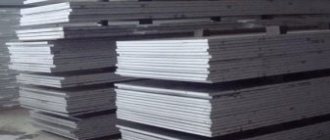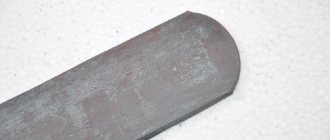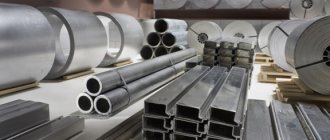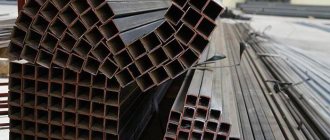The abbreviation HSS, made up of the initial letters of the English words High Speed Steel, denotes a whole group of steels classified as high-speed. Milling cutters, taps, and dies for thread cutting are made from steels of this type. Much less often, such material is used for the production of hacksaw blades and knives.
Alloys of the HSS category refer to high-carbon steels, some grades of which may contain significant amounts of tungsten. The hardness of a tool made from this type of steel can be in the range of 62–64 units on the HRC scale.
End mill made of HSS-Co8 steel is capable of processing material with a tensile strength of up to 1100N/mm2
Tools made from HSS steels, when compared with carbide steels, are more affordable and have higher strength, which allows them to be successfully used for interrupted cutting. Meanwhile, processing with their help is allowed at lower cutting speeds when compared with carbide drills.
The composition of high-speed steels, which foreign manufacturers call HSS alloys, has been constantly improved. So, from the end of the 19th century, a significant amount of tungsten began to be added to such steels (up to 18%), and from 1912 cobalt began to appear in these alloys. It was only in 1930 that molybdenum was included in HSS steels.
How do HSS drills differ from carbide models?
First of all, HSS drills differ from carbide drills in their material manufacturing technology.
- High-speed steel is produced by adding tungsten, chromium, molybdenum and other components to carbon steel. The material of HSS drills is highly durable.
- Carbide is a composite material made using powder metallurgy technology. It consists of micron-sized particles. The main component is tungsten carbide. Additional ones include titanium carbide, tantalum carbide, etc.
Carbide tools from HSS drills are characterized by higher hardness and heat resistance. However, hard alloys have lower strength. They are afraid of vibrations and force loads. This does not allow the use of carbide drills for intermittent machining of workpieces at high speeds.
Due to the complex manufacturing technology, carbide tools are expensive. Prices for drills made of high-speed steel are much lower.
This is interesting: Stainless steel grades - classification, decoding
What is HSS steel
The abbreviation HSS is derived from the English High Speed Steel - “high-speed steel”. It is used in the production of various tools for working with metal products. For production, the classical method of casting into ingots followed by rolling and forging is used. The powder method is also used - spraying a stream of liquid steel with nitrogen.
HSS alloys belong to the high carbon group, some grades of which contain a certain amount of tungsten. The hardness of tools made from this material corresponds to 62-64 units on the HRC scale.
Products made from high-speed steel have increased strength and are in an affordable price segment.
Classification by size
To choose the best drill and not overpay, it is enough to know what length sizes these products are usually divided into. If drilling metal does not require making deep holes, then purchasing models that are too long will lead to cost overruns.
It is customary to classify drills by length as follows:
- Short, 20-131 mm long. Tool diameters are in the range of 0.3-20 mm.
- Elongated, length is 19-205 mm, and diameter is 0.3-20 mm.
- Long series with a diameter of 1-20 mm and a length of 56-254 mm.
When performing drilling work of various depths, you should select the tool that is most suitable for the specific task.
HSS-R, HSS-G, HSS-Co, HSS-E — trunk_2007
Regarding the Queen of the Fields Р18GradeCCrMoWVCoР18T1
| 0,73-0,83 | 3,8-4,4 | <1,0 | 17,0-18,5 | 1,0-1,4 | <0,50 |
| 0.65–0.80 | 3.75–4.00 | — | 17.25–18.75 | 0.9–1.3 | — |
In the 70s of the 20th century, due to a shortage of tungsten, high-speed steel grade R18 was almost universally replaced by steel grade R6M5, which in turn was replaced by tungsten-free steel R0M5F1 and R0M2F3.
The designation HSS stands for “High Speed Steel” and generally applies to the entire class of high speed steels. However, in most cases this is the designation for the most widespread steel of this class - P6M5 (M-2; 1.3343; Z85WDCV; HS 6-5-2; F-5613)
| 0,82-0,90 | 3,8-4,4 | 4,8-5,3 | 5,5-6,5 | 1,7-2,1 | <0,50 |
| 0.95 | 4.2 | 5.0 | 6.0 | 2.0 |
GradeCCrMoWVCoР6М5M2
Approximate translation of European names of steels to our GOSTs: HSS - High Speed Steel - high-speed tool steel, analogue of P6M5 (1.3343 - S6-5-2 DIN). HSS-R - rolled tool.
HSS-G - tool steel, analogue of P6M5. G (Grinding) - polished tool.
HSSE, HSS-E, HSS-Co version of HSS-G alloyed with cobalt is usually M35 - tool high-speed steel, analogue of R6M5K5. CHSS-Co8 - tool high-speed steel, analogue of R6M5K8 - M42.
“M42 is a molybdenum series high speed steel alloy wit,h an additional 8% cobalt. It is widely used in metal manufacturing because of its superior red-hardness as compared to more conventional high speed steels, allowing for shorter cycle times in production environments due to higher cutting speeds or from the increase in time between tool changes. M42 is also less prone to chipping when used for interrupted cuts and cost less when compared to the same tool made of carbide. Tools made from cobalt-bearing high speed steels can often be identified by the letters HSS-Co. "
CV - chrome vanadium tool steel.
About HSS-R, Google gives an adequate link exactly 1 - to the section on high-speed steels in the German Wiki. Holy shit.
Recommendations for selecting HSS drills
The following factors directly influence the choice of HSS drills.
- Grade of processed steel. The choice of tool based on the material of manufacture depends on it.
- Equipment that needs to be equipped with a drill. Buy drill bits with shanks that fit the equipment you have.
- Frequency of use. If you are looking for an HSS drill for one-time jobs, inexpensive models are suitable. If you use the tool often, do not skimp on quality.
You will find detailed information about choosing metal drills for various jobs in this article (put a link to the page with article No. 1).
Marking of HSS drills, their types and domestic analogues
All drills made from HSS steel are marked accordingly. There are three varieties of this steel.
- Tungsten (T1–T15).
- Molybdenum (M1–M36).
- Highly alloyed (M41–M62).
Tungsten HSS drills
From this group, drills made from four types of steels are most widely used.
- T1 (domestic equivalent - P18). This HSS steel (18% tungsten) with high characteristics (grindability, strength and wear resistance) is used to make drills and other general purpose tools. They are best suited for machining carbon and alloy structural steels.
- T2 (domestic analogue - R18F2). The alloy contains 2% vanadium. It is used for the manufacture of finishing and semi-finish drills intended for processing medium-alloy structural steels.
- T3 (domestic analogue - Р18K5Ф2). The alloy contains 18% tungsten, 5% cobalt and 2% vanadium. Such tools are characterized by increased secondary hardness and wear resistance, but have low grindability. Drills of this type are best suited for processing workpieces made of high-strength, corrosion-resistant and heat-resistant steels and alloys.
- T15 (domestic equivalent - R12F5K5). This marking on HSS drills means that in addition to 12% tungsten, vanadium (5%) and cobalt (5%) are added to the alloy. These tools are characterized by high strength, toughness and wear resistance. They are used when drilling difficult-to-cut materials.
Image No. 1: composition of tungsten HSS steels
Molybdenum HSS drills
The main alloying component of steels in this group is molybdenum. Also in different quantities may contain:
- tungsten,
- cobalt;
- vanadium;
- carbon;
- and other components.
Image No. 2: composition of molybdenum HSS steels
The most widely used are HSS drills made from the following types of molybdenum high-speed steels.
- M1. General purpose tools are produced from this grade of steel (8% molybdenum). These HSS drills are highly flexible and resistant to impact loads. Red fastness is lower than that of analogues.
- M2 (domestic equivalent - P6M5). This is the most common material for the production of HSS drills. The alloy contains 6% tungsten and 5% molybdenum. It has balanced strength, hardness and heat resistance.
- M3 (domestic equivalent - R6M5F3). This alloy also contains 3% vanadium. HSS drills made from this steel have lower abrasive wear.
- M7. The main alloying components are molybdenum (8.75%), vanadium (2%) and tungsten (1.75%). Drills made from this HSS steel are used for drilling hard and thick sheet metals.
- M35 (domestic equivalent - R6M5K5). In addition to tungsten, molybdenum and vanadium, this alloy contains cobalt (5%), as well as small amounts of manganese, silicon and nickel. The advantages of this material are good toughness, excellent grindability, heat and wear resistance. HSS drills made from this alloy are used when processing workpieces made of improved alloy and stainless steels under conditions of increased heating of the cutting edge.
High alloy HSS drills
To produce high-alloy HSS drills (having high impact strength and operating in cold conditions), molybdenum group alloys are used, which are subjected to special heat treatment.
Image No. 3: composition of high-alloy HSS steels
- M47 (domestic analogue - R2AM9K5). Contains large quantities of molybdenum (9%) and cobalt (4.7–5.2%). The alloy has an increased tendency to decarburization and overheating during quenching. Sandability is low. HSS drills made from this alloy are used for machining workpieces made of improved alloy and stainless steels.
- M42. Contains a large amount of cobalt and molybdenum (8 and 9.5%, respectively). HSS drills made from this alloy are characterized by increased red hardness and abrasion resistance. Such tools are used when processing viscous and complex metals.
This is interesting: Welding stainless steel at home: options, tips, videos
How are domestic products labeled?
The marking of high-speed steel differs only in numerical designations (the letter is the same everywhere - “M”).
The number contains an indication of various characteristics of the material:
- M1. This steel is used to make universal products. It has great flexibility and tolerates mechanical stress well. The level of red fastness here is low.
- M2. This material most often serves as the basis for the production of universal drills. Grade M2 has high red resistance, which allows cutting devices to maintain their functionality for a long time.
- M7. This material is mainly used to produce products of considerable power, which must be not only flexible, but also reliable. Metal drills grade M7 are used for drilling hard surfaces of large thickness.
- M50. Drills made from this alloy are typically used in portable applications, where significant bending of the tool is the most common cause of failure. The level of red fastness here is lower compared to other brands.
- M35. The abbreviation HSSE may also be used to refer to this material. Cobalt is present here in greater quantities, which makes the material more red-resistant compared to M2 steel. There is also the opposite effect - because of this, shock loads are not tolerated so well by instruments.
- M42. The proportion of cobalt here is very significant, which explains another name for the alloy - “supercobalt”. Tools made from M42, along with excellent red resistance, withstand abrasion very well. This type of steel is mainly used to produce tools for working with complex, stubborn materials.
Characteristics and grades of HSS steel
High-speed varieties are high-carbon steels. Some brands contain a fairly large amount of tungsten. In addition, they may contain cobalt and molybdenum. If we talk about the hardness of alloys, the indicator is most often in the range of 62–64 units of the HRC scale. Comparing products made from high-speed steel and carbide, it is worth noting that the first option is distinguished by a fairly affordable price and increased wear resistance.
Recently, it has been customary to distinguish 3 main groups of HSS steel, each of which has its own characteristics:
- High tungsten content (T)
- High Molybdenum (M)
- High alloy
Tungsten steels
Not the most popular variety. This is due to the fact that tungsten is quite rare and expensive. The most common grades of tungsten steel are T1 and T15. The second contains cobalt and vanadium, therefore they are suitable for the production of accessories that have increased requirements for strength and resistance to high temperatures.
Chemical composition of tungsten HSS steels
| Type | Analogue | C | Mn | Si | Cr | V | W | Mo | Co | Ni |
| T1 | P18 | 0,75 | — | — | 4,00 | 1,00 | 18,00 | — | — | — |
| T2 | R18F2 | 0,80 | — | — | 4,00 | 2,00 | 18,00 | — | — | — |
| T4 | R18K5F2 | 0,75 | — | — | 4,00 | 1,00 | 18,00 | — | 5,00 | — |
| T5 | 0,80 | — | — | 4,00 | 2,00 | 18,00 | — | 8,00 | — | |
| T6 | 0,80 | — | — | 4,50 | 1,50 | 20,00 | — | 12,00 | — | |
| T8 | 0,75 | — | — | 4,00 | 2,00 | 14,00 | — | 5,00 | — | |
| T15 | R12K5F5 | 1,50 | — | — | 4,00 | 5,00 | 12,00 | — | 5,00 | — |
Molybdenum and high alloy steels
They are very widespread. May contain cobalt and tungsten. Those brands whose formula includes carbon and vanadium are characterized by increased strength and wear resistance, and resistance to abrasives. Alloys, starting with M41, are used to produce devices that retain their characteristics even when super heated. To create equipment designed for work at low temperatures, steels with molybdenum are also used, but they are subject to additional processing.
Chemical composition of molybdenum HSS steels
| Type | Analogue | C | Mn | Si | Cr | V | W | Mo | Co | Ni |
| M1 | 0,80 | — | — | 4,00 | 1,00 | 1,50 | 8,00 | — | — | |
| M2 | P6M5 | 0,85 | — | — | 4,00 | 2,00 | 6,00 | 5,00 | — | — |
| M3 | P6M5Ф3 | 1,20 | — | — | 4,00 | 3,00 | 6,00 | 5,00 | — | — |
| M4 | 1,30 | — | — | 4,00 | 4,00 | 5,50 | 4,50 | — | — | |
| M6 | 0,80 | — | — | 4,00 | 2,00 | 4,00 | 5,00 | — | — | |
| M7 | 1,00 | — | — | 4,00 | 2,00 | 1,75 | 8,75 | — | — | |
| M10 | 0,85–1,00 | — | — | 4,00 | 2,00 | — | 8,00 | — | — | |
| M30 | 0,80 | — | — | 4,00 | 1,25 | 2,00 | 8,00 | — | — | |
| M33 | 0,90 | — | — | 4,00 | 1,15 | 1,50 | 9,50 | — | — | |
| M34 | 0,90 | — | — | 4,00 | 2,00 | 2,00 | 8,00 | — | — | |
| M35 | R6M5K5 | 0,82–0,88 | 0,15–0,40 | 0,20–0,45 | 3,75–4,50 | 1,75–2,20 | 5,5–6,75 | 5,00 | 4,5–5,5 | up to 0.30 |
| M36 | 0,80 | — | — | 4,00 | 2,00 | 6,00 | 5,00 | — | — |
Chemical composition of high alloy HSS steels
| Type | Analogue | C | Mn | Si | Cr | V | W | Mo | Co | Ni |
| M41 | R6M3K5F2 | 1,10 | — | — | 4,25 | 2,00 | 6,75 | 3,75 | 5,00 | — |
| M42 | 1,10 | — | — | 3,75 | 1,15 | 1,50 | 9,50 | 8,00 | — | |
| M43 | 1,20 | — | — | 3,75 | 1,60 | 2,75 | 8,00 | 8,25 | — | |
| M44 | 1,15 | — | — | 4,25 | 2,00 | 5,25 | 6,25 | 12,00 | — | |
| M46 | 1,25 | — | — | 4,00 | 3,20 | 2,00 | 8,25 | 8,25 | — | |
| M47 | R2AM9K5 | 1,10 | — | — | 3,75 | 1,25 | 1,50 | 9,50 | 5,00 | — |
| M48 | 1,42–1,52 | 0,15–0,40 | 0,15–0,40 | 3,50–4,00 | 2,75–3,25 | 9,50–10,5 | 0,15–0,40 | 8,00–10,0 | up to 0.30 | |
| M50 | 0,78–0,88 | 0,15–0,45 | 0,20–0,60 | 3,75–4,50 | 0,80–1,25 | up to 0.10 | 3,90–4,75 | — | up to 0.30 | |
| M52 | 0,85–0,95 | 0,15–0,45 | 0,20–0,60 | 3,50–4,30 | 1,65–2,25 | 0,75–1,50 | 4,00–4,90 | — | up to 0.30 | |
| M62 | 1,25–1,35 | 0,15–0,40 | 0,15–0,40 | 3,50–4,00 | 1,80–2,00 | 5,75–6,50 | 10,0–11,0 | — | up to 0.30 |
When selecting products made from molybdenum material, it is worth considering the features of a particular brand:
- M1. Ideal for releasing drills. They are flexible and shock resistant. But they cannot boast of significant red fastness.
- M2. One of the most popular materials. Often used for the production of tools for various purposes. The product is suitable for intensive work using machines. The main feature of such a tool is its exceptional red resistance, which means the cutting element will retain its qualities for a long time. Our catalog presents drills of the HSS-STANDARD series made of this alloy
- M7. Ideal for producing large drills designed for drilling materials of increased hardness or thick sheets.
- M35. It has increased red fastness due to the increased amount of cobalt in the formula. But it has low resistance to shock loads.
- M42. Contains a large amount of cobalt, therefore it has excellent red fastness. In addition, it is extremely resistant to abrasion. Ideal for making accessories for working with particularly hard or even viscous materials. Core cutters made from this material are presented in the HSS-CO 8 line of drills
- M50. Often used to produce drills that come with portable equipment.
Red resistance is a property that alloys obtain due to the presence of tungsten in their composition. The whole point of this feature is that the cutting edge of the equipment retains all its characteristics even if exposed to a temperature of 530 degrees. Steels with cobalt in the formula can withstand even greater heat.
What steel are metal drills made of and which is better?
To choose high-quality drills that can last a long time and maintain sharpness despite repeated use, it is important to know what types of steel such a tool is made from and what their differences are. The best metal drills are made from high-speed steel HSS (a common abbreviation) with the addition of a number of impurities
The price of the instrument and the properties described above depend on their type and quantity.
High speed steel is characterized by its high hardness, ability to resist fracture and tolerance of temperature resulting from drilling speed. The material is doped with special impurities, which is indicated in the marking.
For example:
- P - reports that tungsten is present in the alloy.
- F is an indicator of the presence of vanadium.
- M - indicates the addition of molybdenum.
Sometimes manufacturers list the type of steel as a special benefit of their products. What can such a marking tell us? Let's look at popular options.
Drill bits made of HSS-E steel
5-8% cobalt is added to this high-speed steel. This technological solution allows them to drill into stainless steel with a tensile strength of up to 1200 N/mm2. Designed for particularly astringent and difficult materials when heated. Instead of the letter E, they may be designated Co.
HSS-E steel drill
Drills made of steel HSS-TiAIN
They have a three-layer coating (titanium-aluminum-nitride). This increases their heat resistance to a temperature of 900 degrees and allows them to be used on steel with a strength of 1100 N/mm2. They have an increased service life, 5 times longer than other types.
Drill made of HSS-TiAIN steel.
Drills made of HSS-TiN steel
The marking indicates that the outer layer is sprayed with titanium nitride. This adds strength and increases heat resistance up to 600 degrees. Suitable for making holes in cast iron, aluminium, carbon and alloy steel with a tensile strength of 1100 N/mm2.
Drill made of HSS-TiN steel.
Drill bits made of HSS-G steel
Suitable for cast iron and various types of steel with a tensile strength of 900 N/mm2. The cutting part in them is polished using cubic boron nitride. This gives resistance to radial runout and abrasion resistance. Drills made of this steel are the most common.
Drill made of HSS-G steel.
Steel drill bits HSS-R
This is a high-speed steel with the lowest durability. It can also be indicated simply without the letter R, which will mean conventional heat treatment (hardening) and roller rolling. Suitable for creating holes in mild steel and cast iron.
Drill made of HSS-R steel.
Carbide drills
This type of material only touches the tip of the drill. It is designed to withstand very high temperature loads and is abrasion resistant. This HHS is used for drills designed to work with titanium alloys, heat-resistant steels and stainless steel.
Carbide drills.
The best manufacturers
To purchase drills and be sure that the declared characteristics are completely true, you need to choose the right manufacturer.
Companies that value their reputation do not sell products of inadequate quality. Therefore, when choosing metal drills, you should give preference to manufacturers who have been on the market for a long time.
Among the newcomers, there may also be worthy producers. But in order to find out that a good quality product is on sale, you need to make a purchase, which often represents a “lottery”.
The best manufacturing companies:
1. Bosch - products of the German company have long proven themselves only on the positive side. Despite the rather high price of the products, when purchasing Bosch drills, you can rest assured of excellent quality. It is convenient and profitable to purchase tools from this company as a set.
Whatever set of drills you take, each one will contain only the highest quality products that will last for many years, provided they are properly stored and used.
2. “Zubr” is a domestic manufacturer whose products are maximally optimized in terms of price-quality ratio. You can purchase the products of this company either in a single copy or in the form of a set. The latter option will significantly save money, despite the significant cost of the kit.
3. Soviet-made drills - this category of cutting tools can be classified as an “endangered species.” With due diligence, you can purchase a rarity that has unsurpassed technical characteristics.
Video:
As is commonly referred to in the West
A drill made from a similar material in the West is marked as “HSS”. The presence of additional letter indicators helps to form an idea of the alloying method.
Decoding of the designations accepted in the West:
- HSS(R). The least resistant drills made by roller rolling in high heat mode.
- HSS G. The cutting edge here is ground with Borazon. These are the most popular tools due to their high durability. During drilling, the vibration effect is minimal.
- HSS E. The letter “E” makes it clear that the composition contains cobalt. Drills of this type can make holes in complex materials of high viscosity (M35 alloys are labeled this way on the domestic market). In some cases, the manufacturer may be more precise in specifying the percentage of cobalt (for example, HSS-Co 5 or HSS-Co8).
- HSS G TiN. Titanium nitride is used as sputtering in this case. This allows you to make the surface layer of the tool an order of magnitude harder, while increasing the resistance to heat up to + 600 degrees.
- HSS G TiAIN. An indication of the spraying of drills with titanium nitride, which is additionally alloyed with aluminum. In this way, an increase in the strength of the protective layer by almost 3000 HV is achieved. Heat resistance increases by almost 900 degrees.
- HSS E VAP. Designed for drilling stainless steel substrates: chips practically do not stick here. Failures of products in this series occur extremely rarely, and the holes are of very high quality.
- HSS 4241. Devices marked in this way are used to process wood, plastic and aluminum products.
Legend
The designation of foreign manufacturers does not fully disclose the chemical composition of the HSS steel from which the products are made. A particular tool is assigned a specific task, which is described in the catalog. Other details can be found out by determining the chemical composition, this can be done using a portable metal analyzer, or by testing the products experimentally. Such marking, of course, may be convenient for an unscrupulous manufacturer who may indicate HSS steel on the drill, but it will not meet the necessary requirements. Below are the main markings that characterize the material from which the tool is made and its scope of application.
HSS-R
(or simply HSS) is a designation on products that have undergone roller rolling and heat treatment. Such products have the lowest durability.
HSS-G
- designation on products that are made of HSS steels, the cutting part is ground with CBN (cubic boron nitride). The products have increased durability and less radial runout. HSS-G tools are the most common and are used to solve standard problems.
HSS-E
– cobalt is added to products made from HSS steel type M35. Used when working on viscous and complex materials. There are also such markings as HSS Co 5 and HSS Co 8, which indicate cobalt content of 5 and 8%
HSS-G TiN
– this marking indicates the deposition of titanium nitride. This coating allows increasing surface hardness by approximately 2300 HV and heat resistance up to 600°C.
HSS-G TiAlN
— surface of products coated with titanium-aluminum-nitride. This coating allows increasing surface hardness by approximately 3000 HV and heat resistance up to 900°C.
HSS-E VAP - VAP
-used for processing stainless steels (V2A and V4A). It is obtained by “evaporating” the oxide non-metallic layer. This reduces the adhesion of workpiece chips to the tool surface, which can lead to product failure. As a result, the surface quality is improved and, thanks to VAP, the adhesion of the coolant to the tool surface is improved.
| Characteristics of heat resistance of carbon and red resistance of high-speed tool steels | |||
| steel grade | Temperature, °C | Exposure time, hour | Hardness, HRC e |
| U7, U8, U10, U12 | 150—160 | 1 | 63 |
| P9 | 580 | 4 | |
| U7, U8, U10, U12 | 200—220 | 1 | 59 |
| R6M5, R6M5K5, R9, R9M4K8, R18 | 620—630 | 4 | |
Features of heat treatment
The result of high-temperature processing of high-speed steels is a change in the structure of the material to obtain certain physical and mechanical properties required when working with this tool.
Annealing
HSS steel after the rolling and forging process acquires increased hardness and internal stress. In this regard, the workpieces are preliminarily annealed. Annealing relieves the internal stress of the material, improves machinability and prepares it for hardening.
The annealing process occurs at a temperature of about 850-900°C. However, one should be wary of excessively increasing the temperature and duration of exposure, because this may cause the steel to become more hard. Due to the reduced thermal conductivity of the alloy, heating is carried out slowly and evenly.
The products are loaded into the oven at a temperature of 200-300oC, while subsequent heating is increased at a rate of 150-200o/hour. The process ends with slow cooling: first in an oven to 650 ° C, and then to room temperature in the open air.
To protect against decarburization, annealing is carried out in closed boxes with a neutral environment.
Machine-building plants subject a small number of workpieces to isothermal annealing. They are heated to 880-900oC for a short time, and then transferred to an oven with a temperature not higher than 720-730oC for 2-3 hours. To protect against the appearance of excessive internal stresses, the workpieces are cooled in an oven to 400-450°C and then left in the open air.
Conventional annealing takes longer than the isothermal process. Subsequently, the workpieces undergo mechanical processing, and then the tool undergoes the final heat treatment process - hardening and tempering.
Hardening
Tools made of high-speed steel are hardened at temperatures above 1300°C. After the hardening process, repeated tempering occurs at 550-560°C. This temperature is necessary to dissolve a large number of carbides in the austenite to obtain highly alloyed austenite.
With further cooling, highly alloyed martensite is obtained, which contains large amounts of tungsten, vanadium and chromium. Martensite does not disintegrate when heated to 600°C, which gives high-speed steel red-hardness.
To obtain high red-hardness values, the temperature during hardening must be very high. However, there is a limit, when exceeded, rapid grain growth begins in high-speed steel and melting occurs.
Characteristics of high-speed steels
When listing the characteristics, it is necessary to take into account that the created material is necessary for the operation of cutting devices at high levels of friction that arise during the cutting process. High-speed steels have increased hardness and can be used in work requiring high speeds.
Hot hardness
When using cutting devices during operation, heat is constantly released, and about 80% is spent on heating the tool. The temperature of the cutting edge rises and the material is tempered, which entails a decrease in its hardness. Nevertheless, high-speed steel retains its performance even when heated to 500-600°C.
Red fastness
An indicator that takes into account the time period during which steel can withstand elevated temperatures without changing its performance characteristics. An overestimated friction index leads to heating of the metal, which causes changes in the crystal lattice. As a result, some properties of high-speed steel change significantly.
Fracture Resistance
The material used for the manufacture of cutting tools must have high mechanical properties - resistance to brittle fracture. The high strength of the alloy provides the cutting device with resistance to high force, feed and depth of cut, which in turn leads to increased productivity of the process.








